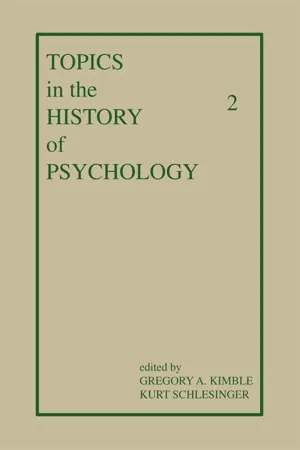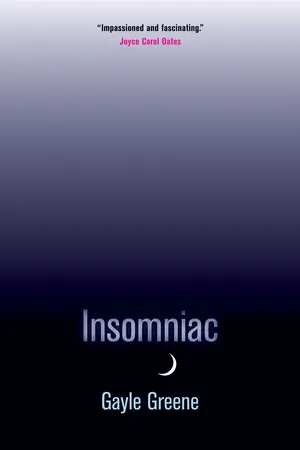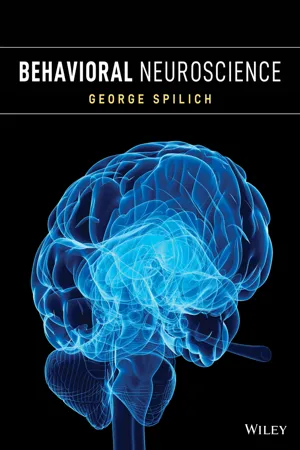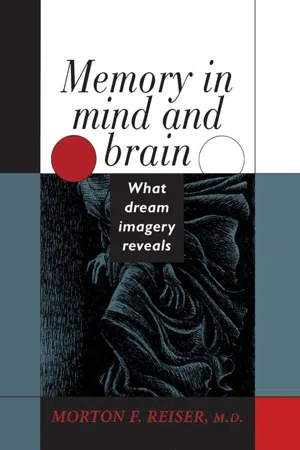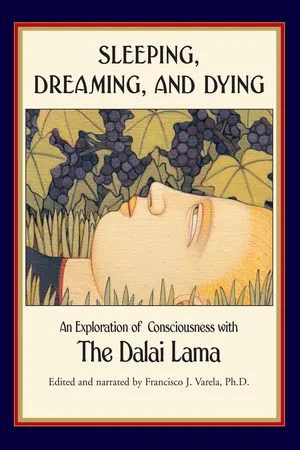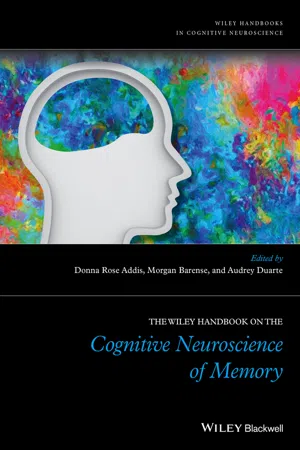Psychology
Brain During Sleep
During sleep, the brain cycles through different stages, including non-rapid eye movement (NREM) and rapid eye movement (REM) sleep. These stages are characterized by distinct patterns of brain activity and serve various functions, such as memory consolidation, emotional processing, and restoration of cognitive function. The brain also undergoes changes in neurotransmitter levels and neural network activity during sleep.
Written by Perlego with AI-assistance
Related key terms
1 of 5
9 Key excerpts on "Brain During Sleep"
- eBook - ePub
Topics in the History of Psychology
Volume II
- G. A. Kimble, K. Schlesinger(Authors)
- 2014(Publication Date)
- Psychology Press(Publisher)
This theory marks yet another point in the constant struggle to bridge the mind-body issues sharpened by the advancing discoveries about the central nervous system. Freud (1900/1965) had found it necessary in his approach to take a different position: “Scientific theories of dreams have no room for any problem of interpreting them, since in their view a dream is not a mental act at all, but a somatic process signalling the occurrence by indications registered on the mental appratus” (p. 128).It can be reasonably guessed that the relationships between neurophysiological correlates of sleep and the mental states associated with sleep as precursors, concomitants, and consequences will remain as fundamental challenges.CONCLUSIONFrom this review of sleep and dreams, it is clear that these areas have not been of central concern in the development of contemporary psychology. They remain of peripheral interest. Of the 13,800 articles appearing in the Psychological Abstracts from January through June, 1981, 218 were indexed under “sleep” and 45 under “dreams.”The apparent lack of interest in these topics is puzzling. As a behavioral event, sleep constitutes roughly a third of the daily behavior of a human adult and two-thirds of that of a neonate. Furthermore, it is a condition before which all other behaviors bow down when it is present and which modifies behavior when it is wanting. As a state of mind, sleep is clearly psychologically challenging; it is a reversible and differentially responsive period of “non-mind,” as well as a breeding ground for a “third” state of unconsciousness, the dream.There are a few obvious contributors to this neglect. Much of the development of contemporary psychology, certainly from the 1920s, has been ordained by behaviorism (of both a small “b” and a large “B” type). From this perspective, sleep has limitations. Is this non-behaving really a behavior? Even if considered a “behavior,” it is sharply restricted in its variability. More critically, at the core of behaviorism’s concern is the mutability or modifiability of the behavior. Sleep is not a response controlled by learning or desire. In this context, sleep is likely to be viewed as a biological system such as digestion or the circulation of the blood—a homeostatic system with limited responsivity to learning, reinforcement, or motivation. Those interested in the sensory or information input side of psychology see their interests disappear with the onset of sleep. In short, sleep can be viewed as a variable which fits neither our theoretical conceptions nor our methods of study. - eBook - ePub
The Dynamic Self in Psychoanalysis
Neuroscientific Foundations and Clinical Cases
- Rosa Spagnolo, Georg Northoff(Authors)
- 2021(Publication Date)
- Routledge(Publisher)
(2019) analyzes some of them. He proposes to consider memory consolidation; gist extraction, and synaptic homeostasis for NON-REM sleep; as well as cell cleansing and prophylaxis through the metabolic system. While, for REM sleep, he takes into consideration simulation and subsequent habituation to emotional scenes and their memory consolidation; non-declarative memory consolidation and integration of newly encoded information with the formation of novel, non-intuitive connections; remembering and stabilizing memories not yet consolidated, as well as forgetting.Psychoanalysis, the cognitive sciences, and neurophysiology describe dream activity according to their investigation specificities, which can be summarized as follows:- — the subjectivity of the dream in relation to its contents,
- — the cognitive functions involved,
- — the underlying neuronal scaffolding.
Therefore, neurophysiology describes the organization of sleep through its circuits, the brain structures involved, the electrical organization and neuroimaging, while the other two disciplines, more broadly, share the research on its functions. The search for the meaning of dreams and their interpretation within an analytical framework are, instead, almost exclusive to psychoanalysis.All this suggests that dreaming, and therefore the experience of sleep and the (almost) ubiquitous activity of dreaming in the animal kingdom, can be analyzed from many different perspectives. We will take into consideration some views that are relevant, according to us, to frame dreams back into psychotherapeutic work.From a conventional linguistic point of view, wakefulness and sleeping are a classic duality. This duality is marked by the presence or absence of consciousness.Conscious experience during sleep (i.e. dreaming) has classically been considered a phenomenon entirely distinct from the spontaneous thought and imagery of wakefulness. But to the contrary, emerging evidence suggests that dream experiences may best be conceptualized as a natural extension of waking consciousness, overlapping in both phenomenology and neural mechanism (Wamsley & Stickgold, 2010 ; Domhoff, 2011 ; Horikawa et al., 2013 - eBook - PDF
- Gayle Greene(Author)
- 2008(Publication Date)
- University of California Press(Publisher)
112 CHAPTER 5 The Brain of an Insomniac Insomnia may not be in their head—it may be in their brain and in their body as well. Daniel Buysse, University of Pittsburgh School of Medicine It’s like my sleep thing is broken. I have a cousin who I’d never met, she said the exact same thing — my sleep thing is broken. The discovery of rapid eye movement (REM) revolutionized the un-derstanding of sleep. Here was evidence that sleep is not just the cessation of brain activity but a behavior in its own right, actively generated and ac-tively maintained. Here was evidence that there were two kinds of sleep, REM and so-called nonREM, as distinct from one another as each state is from wakefulness. Now it turned out that beneath the placid exterior of sleep was a world of complex activity, precisely timed, elaborately mod-ulated, regulated by mechanisms about which nobody had a clue. The mystery of sleep is the mystery of the brain, the most complicated three-pound object on earth. A lump of gray matter the consistency of cream cheese, it doesn’t look all that different from a chimp’s brain, yet it contains about a hundred billion neurons (nerve cells), as many as there are stars in the Milky Way. Each neuron connects to thousands of other neurons, and somehow this vast, ever-changing webwork, these hun-dreds of trillions of connections, give rise to all we are and all we know. More was learned about the brain in the 1990 s, the so-called Decade of the Brain, than in all the decades before, but as neuroscientist Antonio Damasio summarizes, The current description of neurobiological phenomena is quite incomplete, any way you slice it. We have yet to resolve numerous details about the function of neurons and circuits at the molecular level; we do not yet grasp the behavior of populations of neurons within a local brain region; and our understanding of the large-scale systems made up of multiple brain regions is also incomplete. - eBook - PDF
- George Spilich(Author)
- 2023(Publication Date)
- Wiley(Publisher)
Take the sur- vey Try It Out: Are You a Lucid Dreamer? to see if you might be a lucid dreamer. fran_kie / Adobe Stock 13.2 Before You Go On Section Summary We progress through sleep cycles consisting of several different phases every night, and this progression is portrayed in a hypnogram. During REM sleep, when most dreams occur, our brain activates sim- ilar to how it activates during real events. Dreaming may be part of the brain’s way of cleaning up the loose ends of the day’s events, more permanently fixing the memories of the day, or dealing with impend- ing events that are on the dreamer’s mind. Lucid dreaming is when the dreamer is aware they are dreaming and can influence the course of the dream. 13.3 The Biological Basis of Sleep 349 13.3 The Biological Basis of Sleep LO 13.3 Identify the brain mechanisms that create sleep. In science, the first step is always to describe, and the second step is to uncover the underly- ing mechanism that creates the phenomenon. So far in our discussion, we have attempted to define sleep and then describe it. There must be some mechanism that rouses our brain from its sleeping state and keeps us alert to our surroundings and responsive to stimulation from without and from within. The search for this mechanism has taken many turns, and tracing the path of discovery will help us understand the entire mechanism. What are the underlying neurological processes that regulate sleep? Sensory Stimulation and Sleep MCAT It was first thought that sleep is a baseline or resting state of our brain, and when suffi- cient sensory stimulation enters our nervous system, we become active and alert. In the 1930s, Belgian neurophysiologist Frédéric Bremer tested the theory that sensory stimulation would cause an animal to awake from slumber. He first cut the brainstem of a cat at a point between the diencephalon and the hindbrain, or roughly between the superior and inferior colliculi in humans. - eBook - PDF
Brain Damage
Bridging Between Basic Research and Clinics
- Alina Gonz and #225;lez-Quevedo(Author)
- 2012(Publication Date)
- IntechOpen(Publisher)
10 Brain Restoration: A Function of Sleep Eva Acosta-Peña, Juan Carlos Rodríguez-Alba and Fabio García-García Departamento de Biomedicina, Instituto de Ciencias de la Salud, Universidad Veracruzana México 1. Introduction Several hypotheses have been suggested in order to answer the question about the biological function of sleep, and although this question is still in discussion, all theories share the proposal that sleep plays a transcendental role for both physical and brain development. It is well known that sleep deprivation impairs cognitive processes (Drummond & Brown, 2001; Nilsson et al., 2005; Smith et al., 2002), total time of rapid eye movements sleep (REM sleep) is increased after stress condition (Rampin et al., 1991), a brief nap during the day improves mood, memory consolidation and alertness during wakefulness (Backhaus & Junghanns, 2006; Hayashi et al., 1999), and also sleep promotes motor recovery following cerebral stroke (Gómez Beldarrain et al., 2008; Siengsukon & Boyd, 2008, 2009a, 2009b). For these reasons, it has been suggested that sleep preserves the brain in optimal conditions to support the damage occurred in different situations throughout the day. Although the exact way by which this occurs in the brain remains unknown, it is possible that sleep could do it by improving the functioning of antioxidant systems, the maintenance of cellular integrity through the synthesis of molecules involved in cellular structure or regulation of cell cycle, as well as improving synaptic efficiency. The purpose of this chapter is to summarize the main studies that demonstrate the role of sleep in brain restoration and, as a result, in body functioning. 2. Biology of sleep-wake cycle Sleep is a biological phenomenon of reversible nature, which is generated and regulated by several complex systems of neuronal networks and neurotransmitters (García-García & Corona-Morales, 2008; Markov & Goldman, 2006; Stenberg, 2007). - eBook - PDF
- Ricardo A Velluti, Pier Luigi Parmeggiani(Authors)
- 2005(Publication Date)
- ICP(Publisher)
Sleep is a very heterogeneous state. Different psycho-physiological phases alternate during each sleep cycle. At present, states are classified as rapid eye movement (REM) sleep appearing at the end of each sleep cycle, and light (S1 and S2) and deep sleep (S3 and S4) constituting non-REM sleep (NREM). These phases are characterized by specific EEG landmarks (see Chapter 5). Moreover, new animal and human studies have shown extremely low frequency oscillations ( < 1 Hz) associated to NREM sleep, delta and spindles activity (Steriade, 1997; Acherman and Borbely, 1998) 1 [email protected] 535 536 C. M. Portas and fast gamma frequencies, cortical oscillations associated with REM sleep similar to the ones observed in the waking state (e.g. Steriade and Amzica, 1996). Imaging studies have also shown distinct patterns of activation in REM and NREM sleep: REM sleep is mainly associated with reactivation of fronto-limbic areas and deactivation of prefrontal regions, while NREM sleep is characterized by a global deactivation (Maquet et al. , 1996; Braun et al. , 1997). Thus, it is crucial to grant full consideration to the way sleep stage physi-ology relates to distinctive cognitive activities. This chapter reviews the cur-rent knowledge on sensory information processing and mentation/dreaming taking place during sleep. Perception There is no direct access to the mental state of a sleeping person. Whatever the sleeper experiences can only be reported upon awakening. The applica-tion of techniques like EEG and especially evoked potentials during sleep allowed us to analyze immediate response to stimuli presentation in the form of brain waves. Studies of evoked potentials The accessibility of the auditory system during sleep explains why audi-tory perception is the sensory modality more exploited during sleep. More limited information exists for sensory processing in modalities other than auditory, such as like somatosensory and visual. - eBook - PDF
- Oleg V. Khlevniuk, Vadim A. Staklo(Authors)
- 1983(Publication Date)
- Yale University Press(Publisher)
Health reflects and ultimately depends upon satisfactory synchronization of the entire array of the body's functional rhythms. This synchronization is accomplished within the brain, which has its own intrinsically generated rhythms that are likewise subject to influence by internal bodily and externally imposed stim-uli and demands. The sleep-wake cycle reflects one of the major functional rhythms of the brain, and as noted in the first epigraph, the REM dreaming phase of sleep has been established as a third major brain-mind state—a window of opportunity for inquiry into mind/brain questions. With the use of modern electroencephalo-graph and polygraph instrumentation, it is possible to identify two alternating major stages of sleep: rapid eye movement (REM) and non-REM sleep. There are four depth levels of non-dreaming sleep (NREM) that are qualitatively similar. Typical visual dreaming oc-curs during the REM or dream periods. Thus the sleep phase of the circadian (twenty-four-hour) sleep-wake cycle contains a REM-NREM ultradian (less-than-twenty-four-hour) cycle. Kleitman (1963) regarded the latter as representing a basic rest-activity cycle. REM periods occur at approximately ninety-minute intervals. Usu-ally there are four or five REM periods of roughly twenty minutes' duration during each night's sleep, usually shorter earlier and lon-ger later in the sleep period. The ninety-minute ultradian rhythm seen during sleep may continue during waking hours, but with quite different psychologic and behavioral manifestations such as movement, eating, drinking, and smoking (Friedman and Fisher 129 BRAIN, COGNITIVE NEUROSCIENCE: THE SECOND KEY 1967). The period of this ninety-minute ultradian rhythm lies be-tween the much shorter ones represented by cardiac rate (approxi-mately one second) and respiration (approximately four seconds) and the much longer ones (twenty-four hours to thirty or ninety days) to be mentioned below. - eBook - ePub
Sleeping, Dreaming, and Dying
An Exploration of Consciousness
- Dalai Lama, Francisco J Varela, B. Alan Wallace, Thupten Jinpa(Authors)
- 2002(Publication Date)
- Wisdom Publications(Publisher)
“Why is this realization particularly relevant in understanding the neuroscience of sleep? All research on sleep inevitably deals with radical changes in one’s identity, one’s self, or one’s consciousness. When you go to sleep, all of a sudden you are not there. This automatically raises the elusive notion of self, from which some neuroscientists would rather shy away, not to mention the whole mysterious issue of dreaming.Early Ideas
“Let’s move on to the specifics of the neuroscience of sleep. Looking historically at the research on sleep, we see that the main discoveries have all disproved the view that sleep is passive. Neuroscience started off with the traditional idea that sleep is like switching off the lights of the house, and that human beings left alone with nothing to do will fall asleep.“Advances in research very quickly made it clear that sleep is an active phenomenon. It is a state of consciousness with its own laws. It was Sigmund Freud who first articulated that sleep is an active process. Although he started as a neuroscientist, Freud moved in a different direction, toward psychology, about which we will hear later this week. Around 1900, the first researchers tried to define sleep physiologically. Around 1920, a French scientist named Henri Pieron expressed the dominant modern view of sleep as having three characteristics. First, it is a periodic biological necessity. Second, it has its own internally produced rhythm. Third, it is characterized by an absence of motor and sensory functioning.“I’ll skip several other milestones and jump ahead to a discovery that is of great relevance for us here. In 1957, a group of American researchers described what is known today as the state of REM sleep. REM stands for rapid eye movement. This discovery marks the beginning of the mainstream research that continues very actively today.The Basics of the EEG
“Between 1900 and 1957, neuroscience had come to understand in depth the electrical phenomena of the brain, which made the REM discovery possible. We are going to take a detour now in the presentation, leaving sleep aside for a moment, and speak about recording electricity from the human brain by means of the electroencephalogram (EEG). For half a century, the EEG has been the main noninvasive method of investigating human brain activity. (Recent methods of brain imaging constitute a very important alternative and complement, but let us stay with EEG for the time being.) Without some understanding of the techniques and biology of the EEG, we cannot appreciate the neurobiology of sleep. - Donna Rose Addis, Morgan Barense, Audrey Duarte(Authors)
- 2015(Publication Date)
- Wiley-Blackwell(Publisher)
The Wiley Handbook on the Cognitive Neuroscience of Memory, First Edition. Edited by Donna Rose Addis, Morgan Barense, and Audrey Duarte. © 2015 John Wiley & Sons, Ltd. Published 2015 by John Wiley & Sons, Ltd. The Memory Function of Sleep How the Sleeping Brain Promotes Learning Alexis M. Chambers and Jessica D. Payne 11 Introduction Why do we sleep? Philosophers have pondered this question for centuries, yet despite decades of research scientists are still striving for an answer. Our under- standing of sleep has certainly evolved since the great minds of Plato or Aristotle, who conceived of sleep as resulting from physiological processes such as the digestion of food (Barbera, 2008). Beginning in the late nineteenth century, empirical studies of the time‐course of memory inadvertently pointed toward a special role of sleep in reducing forgetting, but the implications of such findings were initially ignored (Ebbinghaus, 1885). Even when such findings were later seriously considered, sleep was proposed to play only a passive role in reducing memory interference from external, competing stimuli (Jenkins and Dallenbach, 1924; Van Ormer, 1933). Fortunately, technological advances such as the electroencephalogram (EEG) led to the blossoming of more objective sleep research (Dement and Vaughan, 2000), allowing scientists to better understand this unique feature of life, including its active role in memory formation and the specific neural processes underlying this function (See How the sleeping brain impacts memory, below). Sleep stages The technological advances that led to the first all‐night sleep recording in 1953 resulted in the classification of the various stages of sleep still recognized today.
Index pages curate the most relevant extracts from our library of academic textbooks. They’ve been created using an in-house natural language model (NLM), each adding context and meaning to key research topics.
